In the ever-evolving landscape of kitchen appliances, the contact grill has emerged as a favorite among culinary enthusiasts and home chefs alike. This compact and versatile cooking device has transformed the way we prepare meals, offering a unique grilling experience that’s both convenient and enjoyable. As the demand for contact grills continues to soar, it’s fascinating to explore the innovations, market dynamics, and consumer preferences that drive this trend forward. Join us as we delve into the world of contact grill producers, uncovering the challenges they face and the opportunities that lie ahead.
TheRiseofContactGrillsintheWesternWorld
The Rise of Contact Grills in the Western World
In recent years, contact grills have emerged as a favorite among culinary enthusiasts in the Western world. Once a niche product, these grills have now become a staple in modern kitchens, offering a convenient and efficient way to achieve that perfect grill mark on meats, vegetables, and more. Let’s delve into the factors that have contributed to the meteoric rise of contact grills in Europe and the Americas.
The compact design of contact grills has made them a favorite for those with limited kitchen space. These grills are not only space-saving but also easy to store when not in use. Their portability has also played a significant role in their popularity, as they can be effortlessly transported to outdoor gatherings or camping trips.
As health consciousness has grown, so has the demand for healthier cooking methods. Contact grills, with their ability to cook food with minimal oil, have become a preferred choice for health-conscious consumers. The ability to achieve a deliciously charred flavor without the need for excessive oil has been a game-changer for those looking to maintain a balanced diet.
The convenience factor cannot be overstated. Contact grills are typically easy to clean, with non-stick surfaces that prevent food from sticking and making cleanup a breeze. This convenience has made them a practical choice for busy individuals and families who value time-saving kitchen appliances.
The versatility of contact grills has also been a major driver of their popularity. These grills can be used to cook a wide variety of foods, from steak and burgers to vegetables and sandwiches. The even heat distribution ensures that food is cooked thoroughly and consistently, making them a versatile addition to any kitchen.
In the past, contact grills were often seen as a less sophisticated alternative to traditional grills. However, as technology has advanced, so too has the quality and functionality of contact grills. Modern contact grills now come with various features, such as adjustable heat settings, temperature control, and even smoking capabilities. This has allowed them to compete with traditional grills in terms of performance and culinary outcomes.
The influence of culinary culture has also played a role in the rise of contact grills. Chefs and food bloggers have embraced these appliances, sharing recipes and techniques that showcase the versatility and flavor potential of contact grills. This has helped to demystify the appliance and make it more accessible to the average consumer.
The marketing efforts of contact grill producers have been equally influential. With the help of social media influencers and cooking shows, these appliances have been featured in a variety of cooking demonstrations, making them seem more approachable and exciting. The marketing strategies have successfully associated contact grills with fun, healthy cooking experiences.
In Europe and the Americas, the demand for contact grills has been further fueled by the trend towards outdoor living and entertaining. As people spend more time in their gardens and on patios, the need for versatile cooking appliances has increased. Contact grills have become a go-to choice for those looking to add a touch of outdoor flair to their meals.
The rise of contact grills in the Western world is a testament to the evolving needs and preferences of consumers. As the market continues to grow, we can expect to see even more innovation and development in this area. From new designs to enhanced features, the future of contact grills looks promising, and they are poised to remain a popular choice for years to come.
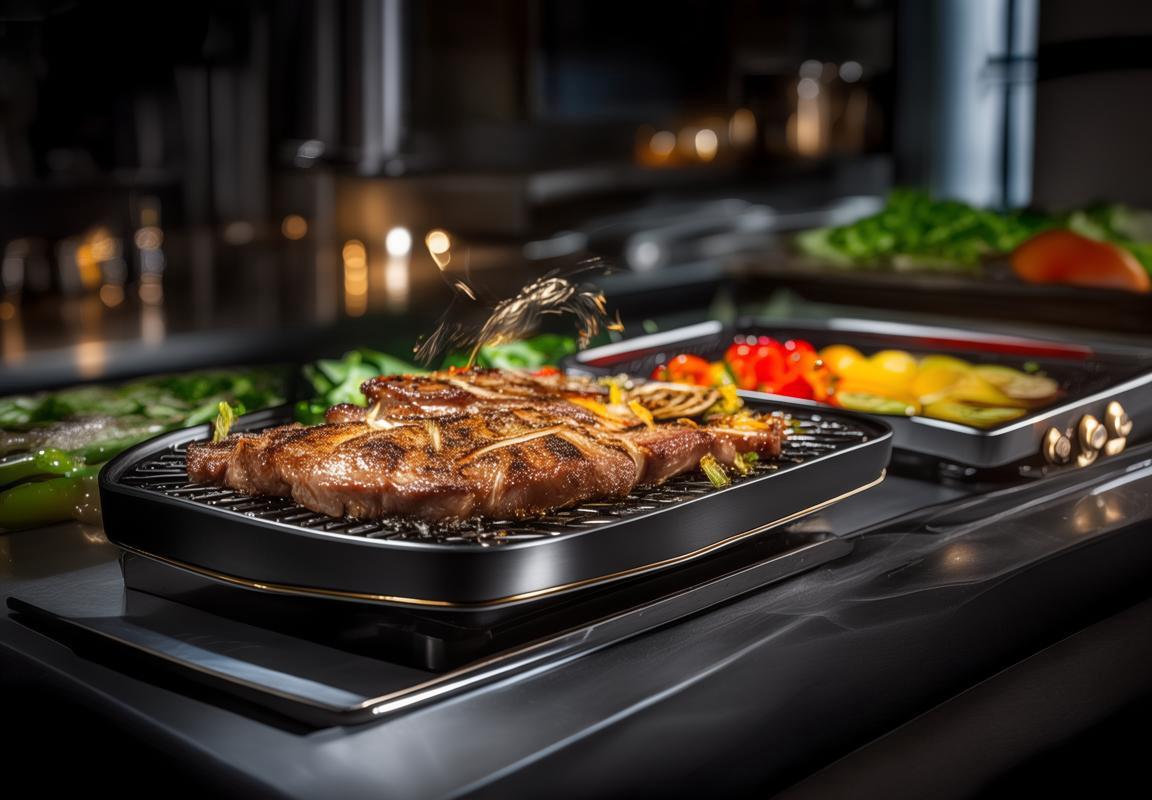
KeyPlayersintheContactGrillMarket
The contact grill market, a segment of the ever-evolving culinary appliance industry, has seen a surge of key players shaping the landscape with innovative designs and technological advancements. Here’s a look at some of the significant players that have made their mark in the contact grill market:
German Engineering with Büchi
Büchi, a renowned name in Germany, has been at the forefront of contact grill production with its commitment to precision engineering. Their grills are celebrated for their durability and the even heat distribution they provide, which is crucial for perfect searing. Büchi’s focus on food safety and hygiene is another standout feature that appeals to both commercial and domestic users.
American Innovation with Char-Broil
Char-Broil, an American brand, has been a staple in outdoor cooking for decades. Their contact grills are known for their versatility and ease of use. With a range of models designed for both small kitchens and large gatherings, Char-Broil has managed to cater to a wide audience. Their recent emphasis on smart grill technology has also garnered attention, offering users the convenience of remote control and connectivity.
Italian Craftsmanship with Roccbox
Roccbox, an Italian manufacturer, has brought a unique approach to contact grills with its handcrafted designs. Known for their sleek and minimalist aesthetics, Roccbox grills are a blend of form and function. They pride themselves on delivering exceptional searing and are favored by chefs and home cooks alike who appreciate the artistry and performance of their products.
French Flair with Actifry
While Actifry is more famous for its fryers, the brand has also ventured into contact grills, blending French culinary tradition with modern cooking technology. Actifry’s contact grills are designed to reduce fat content in cooking, appealing to health-conscious consumers. The French company’s expertise in low-fat cooking technology has made them a key player in the health-conscious segment of the market.
Japanese Efficiency with Sunbeam
Sunbeam, a Japanese company with a global presence, offers a range of contact grills that are known for their efficiency and user-friendliness. Their grills often feature non-stick surfaces and multiple temperature settings, making them a popular choice for busy families and individuals who value quick and easy meals. Sunbeam’s commitment to innovation has led to several patents in grill technology.
British Innovation with Russell Hobbs
Russell Hobbs, a British brand, has a reputation for creating stylish kitchen appliances. Their contact grills are not just about appearance but also about performance. With features like digital temperature control and automatic shut-off, Russell Hobbs has made cooking on a contact grill safer and more precise. Their sleek designs have won over many consumers looking for a blend of elegance and practicality.
Korean Technology with Hansol
Hansol, a South Korean company, has made a name for itself with its advanced contact grills. Known for their state-of-the-art heating elements and rapid heat-up times, Hansol grills offer a premium cooking experience. The brand’s focus on both performance and durability has made them a go-to choice for consumers seeking high-quality kitchen appliances.
Spanish Design with Tefal
Tefal, a Spanish brand, has been a leader in the small kitchen appliance market for years. Their contact grills are no exception, featuring innovative designs that combine ease of use with excellent cooking results. Tefal’s commitment to durability and the use of non-stick coatings means that their grills are not only easy to clean but also long-lasting.
The contact grill market is a competitive space with these key players each bringing their own unique strengths and innovations. From German engineering to Japanese efficiency and Spanish design, these brands are not just manufacturing contact grills; they are crafting experiences that cater to the diverse needs and preferences of consumers around the world.
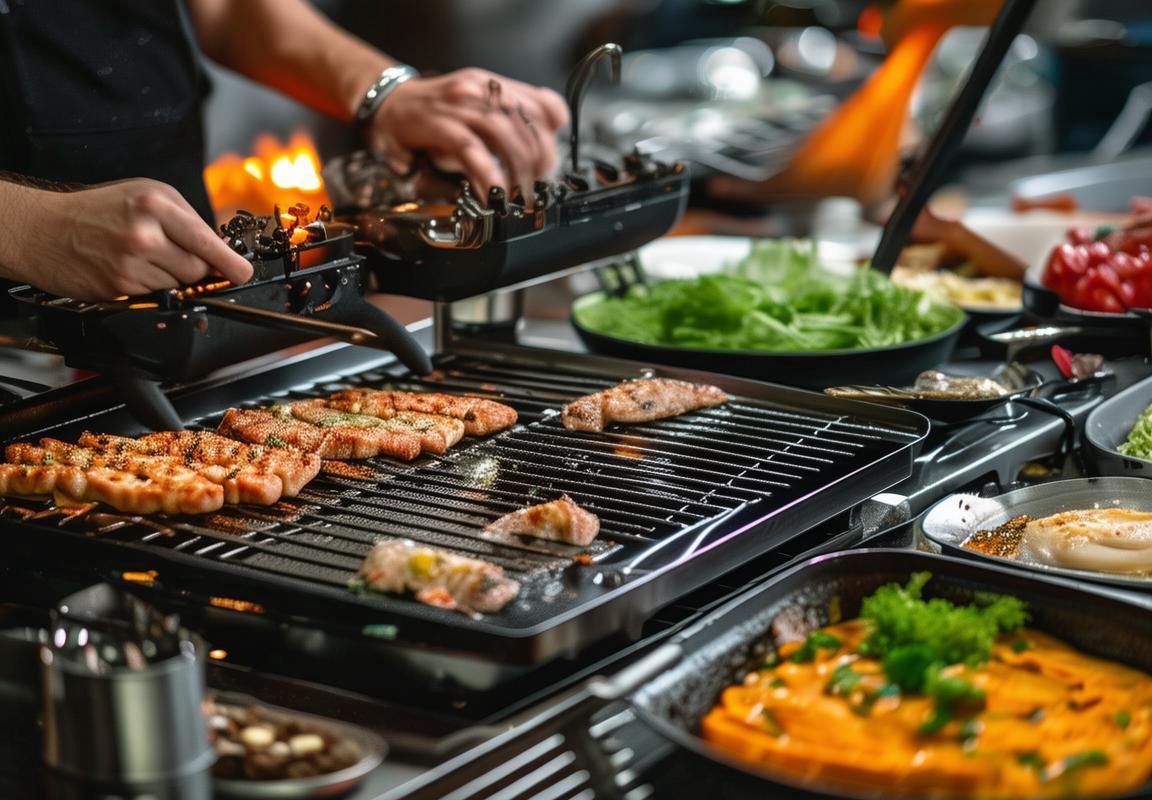
InnovationsinContactGrillTechnology
The evolution of contact grill technology has been a fascinating journey, marked by continuous advancements that have revolutionized the way we cook. From the classic flat grills to the sleek, modern models, here’s a glimpse into the innovations that have shaped the contact grill market.
Grill Plates and Surface MaterialsGrill plates have seen a significant transformation, moving from the traditional cast iron to more advanced materials like stainless steel and ceramic. These materials not only enhance heat distribution but also ensure that the grill surface is easy to clean and maintains its non-stick properties over time. The introduction of induction cooking technology has also allowed for more precise temperature control, which is crucial for achieving perfect grill marks and preventing food from sticking.
Smart Features and ConnectivityModern contact grills are not just cooking appliances; they are smart devices. Many models now come with features like built-in temperature sensors and adjustable cooking settings, allowing users to achieve the perfect sear with ease. Some grills even offer Wi-Fi connectivity, enabling users to control their cooking from their smartphones. This level of connectivity not only provides convenience but also opens up new possibilities for remote monitoring and recipe customization.
Non-Stick Coatings and Health BenefitsThe health-conscious consumer has driven the development of non-stick coatings that are free from harmful chemicals like PFOA and PTFE. These coatings ensure that food releases easily from the grill plate, reducing the need for excessive oil. This innovation not only makes cooking healthier but also simplifies the cleaning process. Producers have also started to incorporate innovative materials that mimic the natural non-stick properties of materials like bamboo, offering a more sustainable and eco-friendly alternative.
Variable Heat ZonesOne of the standout innovations in contact grill technology is the introduction of variable heat zones. These zones allow for different cooking temperatures across the grill surface, enabling users to sear one side of the food while keeping the other side warm or even toasting bread or veggies on a separate section. This feature is particularly beneficial for those who enjoy a variety of cooking techniques and want to minimize the number of appliances in their kitchen.
Safety FeaturesSafety has always been a priority in kitchen appliance design, and contact grills are no exception. Modern grills come with features like automatic shut-off, which turns off the grill if it’s left unattended or if the temperature exceeds a certain threshold. Some models also include safety interlocks that prevent the grill from being opened while it’s still hot. These features not only protect users but also help to prevent accidents and damage to the appliance.
Design and PortabilityThe design of contact grills has evolved to cater to the needs of busy households and individuals who value convenience. Many new models are sleeker and more compact, making them easier to store and transport. Some even come with foldable legs or handles that allow for easy storage in small kitchens or for taking on camping trips. The integration of LED lighting has also made it easier to monitor the grill surface and food preparation at night or in low-light conditions.
Customizable Cooking FunctionsContact grill producers have recognized the importance of customization in cooking. As a result, many grills now offer a range of cooking functions, including direct grilling, indirect grilling, searing, and even baking. Some models even have pre-programmed settings for specific types of food, such as steaks, fish, or vegetables, making it easier for even the most inexperienced cooks to achieve professional-grade results.
Smart Cooking AssistantsThe latest innovation in contact grill technology is the integration of smart cooking assistants. These are essentially apps or software that provide users with step-by-step cooking instructions, recipe ideas, and even nutritional information. By pairing with the grill via Bluetooth or Wi-Fi, these assistants can guide users through the cooking process, ensuring that every meal is cooked to perfection.
In conclusion, the innovations in contact grill technology have made these appliances more versatile, user-friendly, and health-conscious. From advanced materials and smart features to safety enhancements and customizable cooking options, the contact grill market is continually evolving to meet the changing demands of consumers.
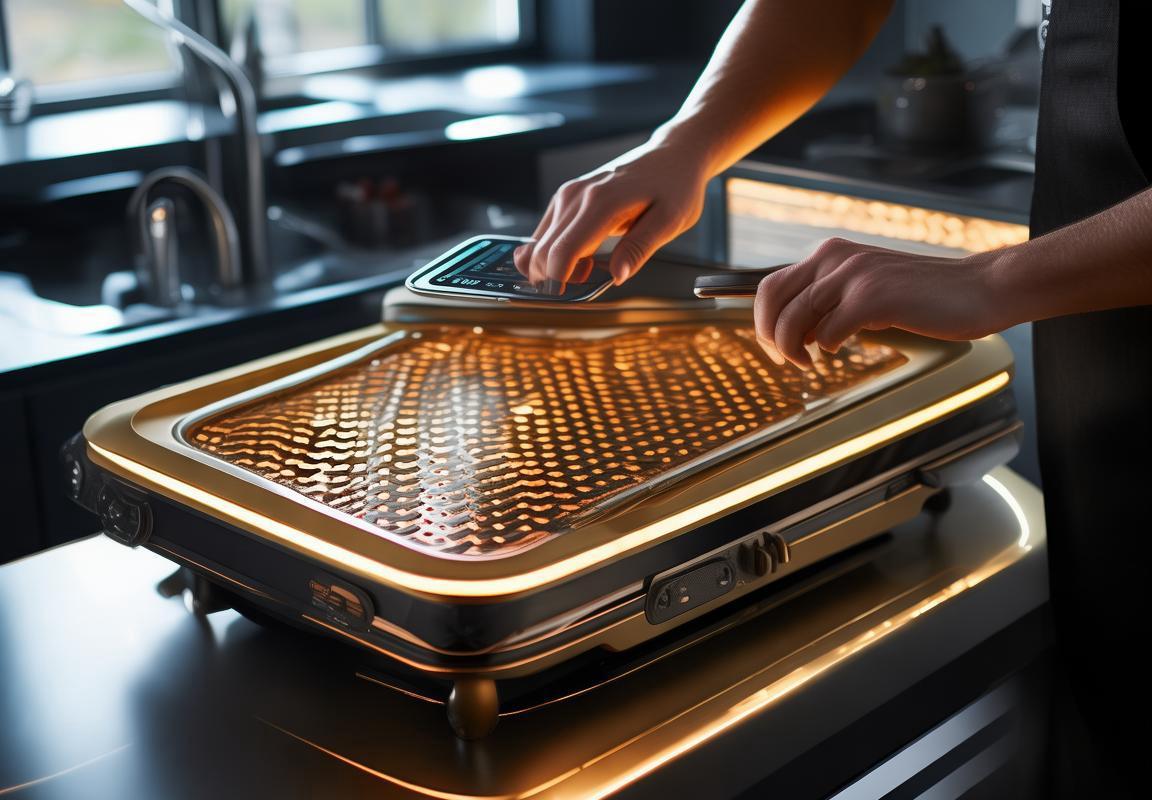
MarketDynamics:Europevs.America
In Europe, the contact grill market has seen a surge in popularity, with consumers embracing the convenience and health benefits it offers. From the bustling streets of Paris to the cozy homes in Stockholm, contact grills have become a staple in many kitchens. Meanwhile, in the Americas, the trend has spread across the continent, from the grilling capitals of Texas to the urban kitchens of New York City.
The European market is characterized by a strong preference for sleek, modern designs. Producers have responded by introducing contact grills that not only excel in performance but also blend seamlessly into contemporary kitchen aesthetics. Brands like Gaggenau and Miele have set the bar high with their premium offerings, which often come with advanced features such as adjustable heat settings and non-stick surfaces.
On the other hand, the American market has a more diverse approach. While there is a significant segment of consumers who value luxury and high-end appliances, there’s also a large group that appreciates more budget-friendly options. Brands like George Foreman and Cuisinart have capitalized on this by offering a range of contact grills that cater to different budgets and needs.
In Europe, the emphasis on health and wellness has led to an increased demand for contact grills that can cook food with minimal oil. Producers have innovated with features like built-in oil catch systems and adjustable heat controls to accommodate this trend. Additionally, there’s a growing interest in smart kitchen appliances, and European contact grill producers are responding with models that can be controlled via smartphone apps, offering users the ability to monitor and adjust cooking temperatures remotely.
In America, the grilling culture is deeply ingrained, and contact grills are often seen as a way to enhance the outdoor grilling experience. Producers have developed contact grills that can mimic the sear of outdoor grills, providing that authentic char without the smoke. Brands like Breville and Hamilton Beach have introduced models that offer variable cooking surfaces and adjustable sear settings, catering to the diverse preferences of American consumers.
The distribution channels for contact grills also reflect the differences between Europe and America. In Europe, high-end models are often found in specialty appliance stores, where customers can expect personalized service and expert advice. In contrast, American consumers can find contact grills in a variety of retail settings, from department stores to big-box retailers, and even online marketplaces like Amazon.
Price points also vary significantly. In Europe, where the cost of living can be higher, contact grills are priced accordingly, with many models falling into the premium category. Conversely, in America, where there is a wider range of income levels, contact grills are available at a variety of price points, from budget-friendly to luxury.
When it comes to marketing strategies, European producers often focus on the technology and innovation behind their products, highlighting features like precise temperature control and energy efficiency. American producers, on the other hand, might emphasize the ease of use and the convenience of contact grills, especially for busy households or those who want to enjoy the taste of grilled food without the hassle of outdoor grilling.
Despite these differences, both the European and American contact grill markets are witnessing a common trend: the integration of technology. From touch controls to Bluetooth connectivity, producers are continuously pushing the boundaries of what a contact grill can do. This technological advancement is not only making contact grills more user-friendly but also more versatile, appealing to a broader audience.
In Europe, the market for contact grills is expected to grow as consumers continue to seek out healthier cooking methods and modern kitchen appliances. The rise of smart homes is also likely to drive demand, as consumers become more interested in integrating their kitchen appliances with their overall smart home ecosystem.
In America, the contact grill market is poised for continued expansion, driven by the increasing popularity of indoor grilling and the convenience it offers. As more consumers look for ways to enjoy the flavors of outdoor grilling without the outdoor preparation, contact grills are likely to become an even more integral part of American kitchens.
The European and American contact grill markets may have their unique dynamics, but they share a common goal: to provide consumers with a versatile, convenient, and enjoyable cooking experience. As producers continue to innovate and adapt to changing consumer preferences, the future of contact grills in both regions looks bright.
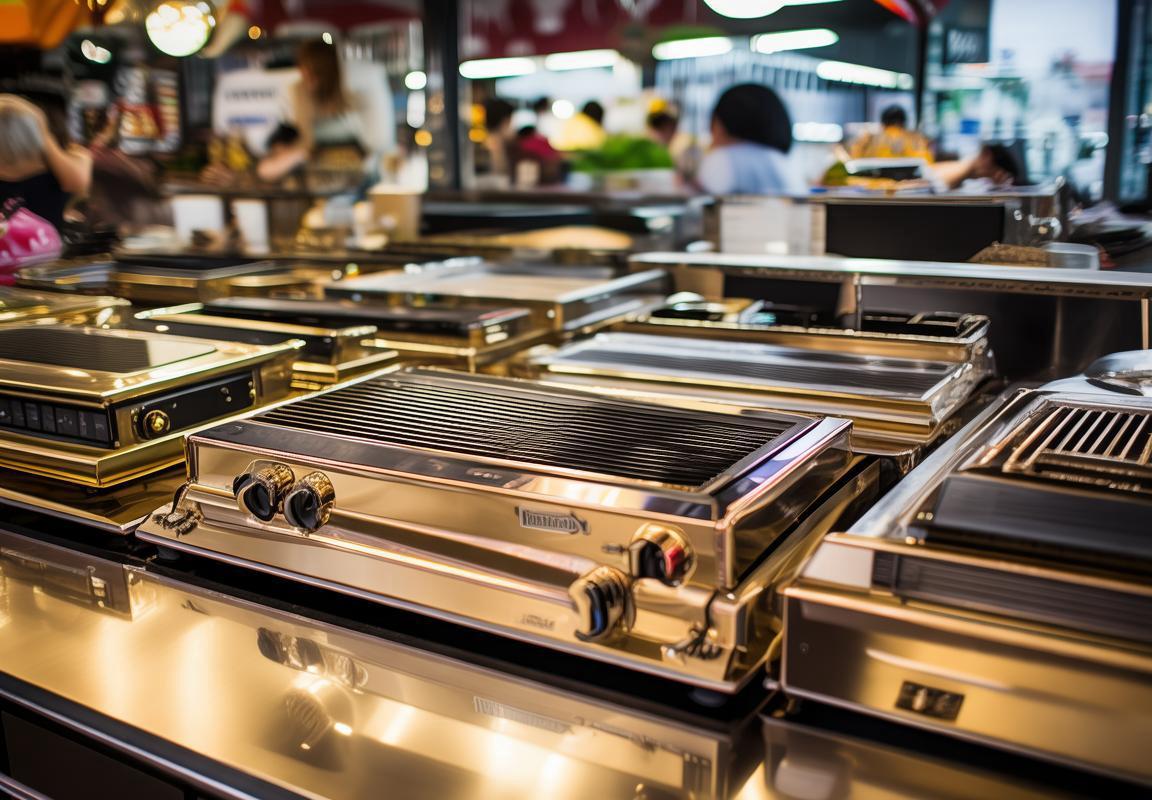
ConsumerTrendsandPreferences
In recent years, the consumer landscape in the contact grill market has evolved significantly, reflecting changing lifestyles, health consciousness, and technological advancements. Here’s an exploration of the key trends and preferences shaping this dynamic sector.
-
Health and Wellness FocusConsumers are increasingly seeking healthier cooking methods that reduce the need for excessive oil or butter. Contact grills have stepped into the spotlight as a preferred option for grilling meats, vegetables, and even sandwiches without the mess and grease associated with traditional frying methods.
-
Versatility and ConvenienceThe ability to use a contact grill for a variety of cooking techniques is a major draw for consumers. From searing steaks to toasting sandwiches, these appliances offer a multi-functional cooking experience. The convenience of quick clean-up and ease of use also play a crucial role in consumer preferences.
-
Design and AestheticsAs kitchen appliances become more integrated into the overall kitchen aesthetic, design has become a key factor. Consumers are looking for contact grills that not only perform well but also complement their kitchen decor. Sleek, modern designs with digital controls and intuitive interfaces are becoming increasingly popular.
-
Smart Technology IntegrationThe rise of smart home technology has influenced consumer preferences in the contact grill market. Users are now seeking grills that can be controlled remotely via smartphone apps, offering features like pre-set cooking times, temperature control, and even notifications when food is ready.
-
Safety and CleanlinessSafety is paramount in any kitchen appliance, and contact grills are no exception. Consumers are looking for features that ensure safe operation, such as non-slip surfaces, cool-to-the-touch handles, and easy-to-clean surfaces. The presence of safety locks and overheating protection is also a significant consideration.
-
Eco-Friendly MaterialsEnvironmental consciousness is on the rise, and this extends to kitchen appliances. Consumers are gravitating towards contact grills made from sustainable materials or those with energy-efficient features that reduce their carbon footprint.
-
Customization and PersonalizationThe ability to customize cooking settings is a growing preference. Features like adjustable heat settings, removable cooking plates, and reversible grids allow consumers to tailor their cooking experience to specific preferences and dietary needs.
-
Value for MoneyDespite the premium nature of contact grills, consumers are looking for the best value for their money. This includes not only the initial cost but also long-term savings on energy and maintenance. High-quality appliances that require minimal repairs or replacements are particularly appealing.
-
Brand Reputation and ReviewsIn the age of online reviews and social media, the reputation of a brand can make or break a product. Consumers rely heavily on reviews and recommendations from peers to make informed purchasing decisions. A strong brand with positive customer feedback can significantly influence buying behavior.
-
Social ResponsibilityCorporate social responsibility is becoming an important factor in consumer purchasing decisions. Brands that demonstrate a commitment to ethical practices, fair labor, and community involvement are gaining a competitive edge in the market.
The contact grill market is responding to these evolving trends by introducing a wide array of products that cater to the diverse needs and preferences of consumers. As the industry continues to grow, it’s likely that we’ll see further innovation and refinement in the features and design of contact grills to meet the ever-changing demands of the market.

TheRoleofSustainabilityinContactGrillProduction
In recent years, sustainability has emerged as a pivotal factor in the production of contact grills, reflecting a broader shift in consumer values and environmental consciousness. This section delves into how sustainability is shaping the contact grill market.
The shift towards eco-friendly materials is a significant trend in contact grill production. Producers are increasingly using recycled steel, aluminum, and stainless steel, which not only reduce the carbon footprint but also extend the lifespan of the grills. These materials are also more resistant to rust and corrosion, making them a durable and environmentally responsible choice.
Energy efficiency is another key aspect of sustainable contact grill production. Manufacturers are focusing on developing grills that consume less energy while maintaining their cooking performance. This includes innovations like induction cooking technology, which provides precise temperature control and reduces energy waste compared to traditional electric grills.
The packaging of contact grills is also undergoing a transformation. Companies are moving away from single-use plastics and opting for biodegradable or recyclable materials. This shift not only minimizes waste but also educates consumers about the importance of reducing their environmental impact.
Water conservation is a growing concern in contact grill production. Some models now come with features that allow for the use of less water, such as adjustable cooking temperatures that prevent overcooking and the need for additional water for basting or cleaning.
The design and manufacturing processes are also being scrutinized for their environmental impact. Producers are exploring alternative methods of assembly that reduce energy consumption and waste. This includes the use of automation and robotics, which can streamline production and reduce the need for manual labor, thereby cutting down on energy use and emissions.
Innovation in heat distribution is another area where sustainability is playing a role. Newer contact grills are designed with more even heat distribution, which not only improves cooking efficiency but also reduces the amount of energy required to achieve the desired results.
The use of smart technology in contact grills is also contributing to sustainability. Smart grills can be controlled remotely, allowing users to preheat them and start cooking at the optimal time, thus reducing energy use. Additionally, these smart features can provide users with data on their cooking habits, helping them make more informed decisions about energy consumption.
The role of sustainability in contact grill production extends to the end of the product’s life cycle. Many manufacturers are now offering recycling programs for their grills, ensuring that at the end of their useful life, they can be properly recycled and their materials reused.
Consumer awareness and demand for sustainable products are driving this shift. As consumers become more informed about the environmental impact of their purchases, they are more likely to choose brands that prioritize sustainability. This trend is not just beneficial for the environment but also for the reputation and long-term success of contact grill producers.
In conclusion, sustainability in contact grill production is not just a trend; it’s a reflection of the changing values of consumers and the broader society. As producers continue to innovate and adapt, they are not only meeting the demands of the market but also contributing to a more sustainable future.
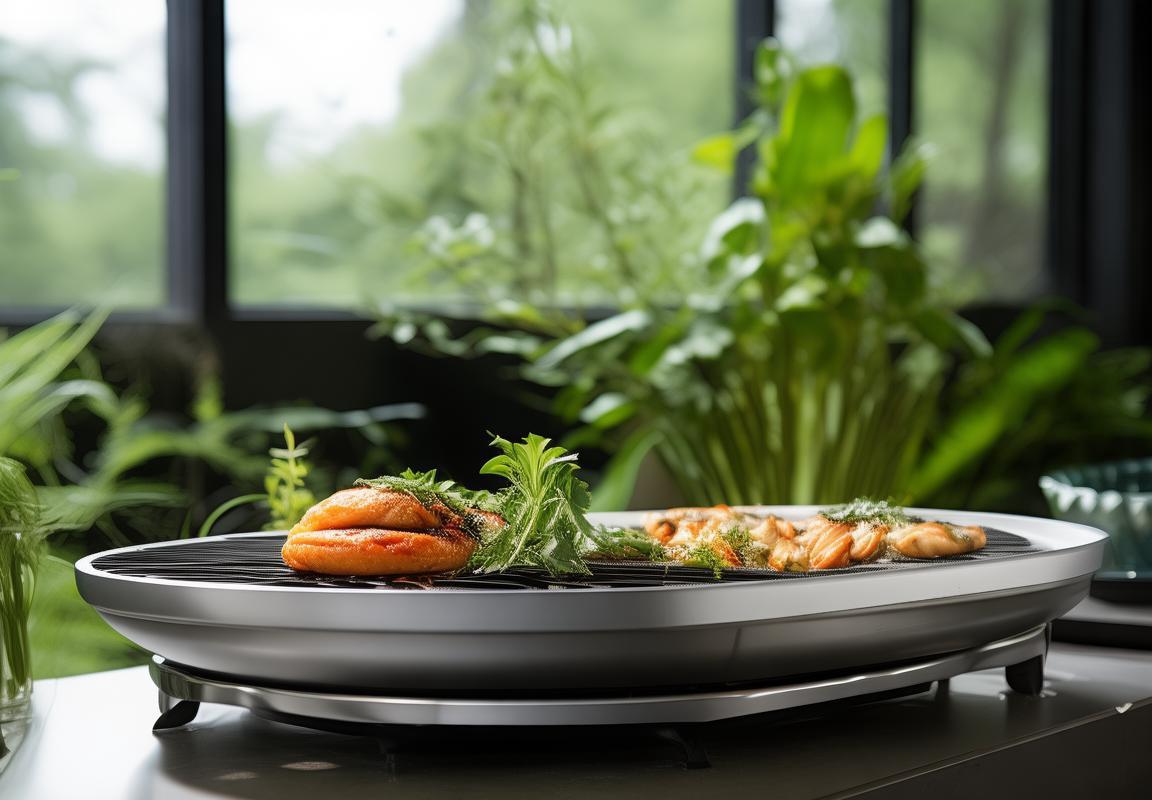
DistributionChannelsandRetailStrategies
In today’s competitive market, the distribution channels and retail strategies employed by contact grill producers are as diverse as the products themselves. From online marketplaces to exclusive in-store experiences, these methods play a crucial role in reaching consumers and differentiating brands.
Brick-and-Mortar Retail ExpansionProducers have been actively expanding their presence in physical retail spaces, strategically placing contact grills in high-traffic areas such as home goods stores and departmental supermarkets. This approach allows consumers to see and touch the product before making a purchase, which can be a significant factor in the decision-making process.
E-commerce RevolutionThe rise of e-commerce has been a game-changer for contact grill producers. With the convenience of online shopping, consumers can browse a wide selection of grills from the comfort of their homes. Producers have responded by optimizing their websites for mobile devices, enhancing product descriptions, and offering detailed images to ensure customers feel confident in their online purchases.
Direct-to-Consumer (DTC) InitiativesSome contact grill brands have chosen to establish direct-to-consumer channels, bypassing traditional retailers. This approach allows for a more personalized customer experience, with the ability to gather direct feedback and tailor marketing strategies accordingly. DTC initiatives often include membership programs, loyalty rewards, and exclusive promotions.
Pop-Up Shops and EventsBrands are increasingly leveraging pop-up shops and events to create a buzz around their contact grills. These temporary retail spaces offer a unique shopping experience, often accompanied by cooking demonstrations and interactive sessions. This strategy not only generates immediate sales but also helps in building brand recognition and loyalty.
Collaborations with InfluencersInfluencer partnerships have become a popular retail strategy for contact grill producers. By collaborating with chefs, lifestyle bloggers, and social media personalities, brands can tap into a broader audience and gain credibility through endorsements. Influencers often share their experiences with the grills, providing a personal touch that can influence consumer decisions.
Exclusive Retail PartnershipsCertain contact grill producers have formed exclusive partnerships with specific retailers, which can be a powerful tool in the market. These partnerships often involve co-branded displays, exclusive product lines, and joint marketing campaigns. The exclusivity not only drives demand but also creates a sense of prestige for the retailer and the brand.
Cross-Selling and BundlingRetail strategies often involve cross-selling and bundling to increase sales. Contact grill producers may offer complementary accessories, such as grill mats, spatulas, or cleaning kits, either as part of a bundle or as additional items at checkout. This approach not only adds value to the customer’s purchase but also introduces them to the brand’s full range of products.
In-store Demonstrations and WorkshopsTo educate consumers and showcase the capabilities of their contact grills, producers are organizing in-store demonstrations and workshops. These events allow customers to witness the grilling process firsthand, ask questions, and even prepare their own meals using the grills. Such experiences can significantly boost sales and foster brand loyalty.
Subscription ModelsSubscription services are gaining traction in the retail space, and contact grill producers are not left behind. By offering monthly or quarterly subscription boxes filled with various grill accessories and recipe guides, brands can create a steady revenue stream and keep their customers engaged over time.
Feedback and Customer ServiceAn often-overlooked aspect of retail strategies is the emphasis on feedback and customer service. Producers that prioritize excellent customer service and actively seek customer feedback can build a strong reputation and foster a loyal customer base. This can be achieved through dedicated customer service hotlines, online chat support, and social media engagement.
In conclusion, the distribution channels and retail strategies employed by contact grill producers are multifaceted and continuously evolving. By blending traditional and innovative approaches, these brands are able to reach a wider audience, enhance the customer experience, and ultimately drive sales in a highly competitive market.

ChallengesandOpportunitiesforContactGrillProducers
Navigating the competitive landscape of contact grill production, companies face a myriad of challenges and opportunities that can shape their future in the market. Here’s a closer look at some of the key hurdles and potential avenues for growth:
The Competitive Edge- The fierce competition in the contact grill market requires producers to continuously innovate and differentiate their products.- Companies must focus on aspects like design, functionality, and customer service to gain a competitive edge over rivals.
Customer-Centric Approaches- Understanding consumer needs and preferences is crucial, as the market evolves with changing tastes and lifestyles.- Producers must adapt their offerings to cater to the desires of health-conscious consumers, who seek high-quality, healthy cooking options.
Technological Integration- Embracing technological advancements is vital for contact grill producers looking to stay ahead.- The integration of smart features, such as remote control capabilities and connectivity with mobile apps, has become a standard expectation.
Environmental Responsibility- As consumers become more environmentally aware, producers must address sustainability concerns in their operations.- This includes using eco-friendly materials and reducing energy consumption in manufacturing processes.
Regulatory Compliance- Contact grill producers must comply with stringent safety and health regulations in both Europe and the Americas.- Adhering to these regulations ensures product quality and maintains consumer trust.
Economic Fluctuations- Economic downturns can impact consumer spending and, subsequently, the demand for high-end kitchen appliances like contact grills.- Producers must be prepared to adjust their strategies in response to economic volatility.
Global Expansion- Expanding into new markets presents both opportunities and challenges for contact grill producers.- Tailoring products to meet the specific needs and preferences of international consumers is a delicate balancing act.
E-commerce Influence- The rise of e-commerce has transformed the retail landscape, offering contact grill producers new avenues for sales and customer engagement.- However, it also demands a shift in focus from traditional brick-and-mortar strategies to online marketing and customer service.
Cost Management- Keeping production costs under control is essential, especially when dealing with the fluctuating costs of raw materials.- Producers must optimize their supply chains and manufacturing processes to enhance efficiency and reduce overheads.
Product Lifecycle Management- The lifecycle of a contact grill product from conception to disposal plays a significant role in a producer’s success.- Implementing strategies for product recycling and waste reduction can not only benefit the environment but also improve brand image.
Consumer Feedback- Actively listening to consumer feedback and incorporating it into product development cycles is a powerful strategy.- This helps in addressing any flaws or unmet needs promptly and can lead to increased customer satisfaction.
Innovation and R&D- Investing in research and development is key to creating new features and improving existing products.- Continuous innovation is necessary to keep up with the rapid pace of technological advancements in the appliance industry.
Partnerships and Collaborations- Forming strategic partnerships with other brands or suppliers can open up new opportunities for contact grill producers.- Collaborations can lead to joint product development, expanded distribution networks, and shared marketing efforts.
Brand Building- Establishing a strong brand presence is crucial for long-term success in the contact grill market.- Effective branding can differentiate a company’s products and build trust with consumers.
In summary, the path for contact grill producers is fraught with challenges and opportunities. By focusing on customer satisfaction, embracing technological innovation, managing costs, and navigating the complexities of the global market, producers can position themselves for sustained growth and profitability.

FuturePredictionsforContactGrillProducers
The evolving landscape of contact grill producers suggests a market ripe with potential. Innovations in technology, changing consumer preferences, and the increasing importance of sustainability all play pivotal roles in shaping the future of this industry. Here are some key predictions that could redefine the future of contact grill production.
As we look ahead, one can an industry increasingly focused on convenience and speed. With busy lifestyles becoming the norm, contact grills are likely to see an uptick in popularity due to their quick cooking capabilities. Features like touchscreens and automatic temperature controls may become standard, simplifying the cooking process for the consumer.
The integration of smart technology is another trend on the rise. Imagine a contact grill that not only cooks your food to perfection but also connects to your smartphone, providing real-time feedback and cooking tips. This level of connectivity could revolutionize how consumers interact with their kitchen appliances.
Sustainability is becoming a core concern for many consumers, and contact grill producers are not immune to this shift. Expect to see an increase in eco-friendly materials, energy-efficient designs, and a greater emphasis on the product lifecycle. Producers might explore the use of recycled materials and invest in manufacturing processes that minimize waste and environmental impact.
Innovation isn’t just about new features; it’s also about addressing common issues. For example, improving the durability of contact grill surfaces to prevent rust and maintain non-stick qualities over time will be a priority. Additionally, the development of healthier cooking options, such as non-toxic coatings and healthier cooking surfaces, could resonate with consumers looking to enhance their diet.
The market is also expected to see a rise in niche players. While large brands have been dominant, smaller companies with unique designs or specialized cooking capabilities might carve out a significant market share. Customization options, like adjustable temperature zones, could become popular, allowing users to cater to their specific dietary preferences or cooking techniques.
Contact grill producers might also explore international markets as a growth opportunity. The concept of the contact grill is still relatively new in some regions, and there’s potential for significant market penetration as consumers become more aware of the product’s benefits.
From a retail perspective, the shift to e-commerce is undeniable. Online sales platforms offer a direct line to consumers, reducing the need for physical retail space and allowing for targeted marketing. Producers might benefit from leveraging social media to showcase the unique features and benefits of their products, driving sales and brand loyalty.
The competitive landscape is likely to see a blend of traditional and online-only retailers. Large home appliance stores might expand their offerings to include a wider variety of contact grills, while specialized online retailers focus on building a niche market around these appliances. The emergence of subscription models could also provide an additional revenue stream for producers, offering regular updates and maintenance services for contact grills.
In terms of regulatory compliance, the future might bring stricter guidelines for food safety and energy efficiency. Producers will need to stay abreast of these changes to remain competitive and compliant. This could mean investing in more rigorous quality control processes and adapting manufacturing practices to meet new standards.
Lastly, the future of contact grill production hinges on the ability to adapt to new consumer needs. As trends in food and nutrition continue to evolve, so too must the appliances that serve them. The industry’s ability to innovate and respond quickly to these changes will be crucial in determining its future success. Whether it’s through advancements in technology, sustainable practices, or a deeper understanding of consumer preferences, the road ahead is one of continuous evolution and opportunity for contact grill producers.
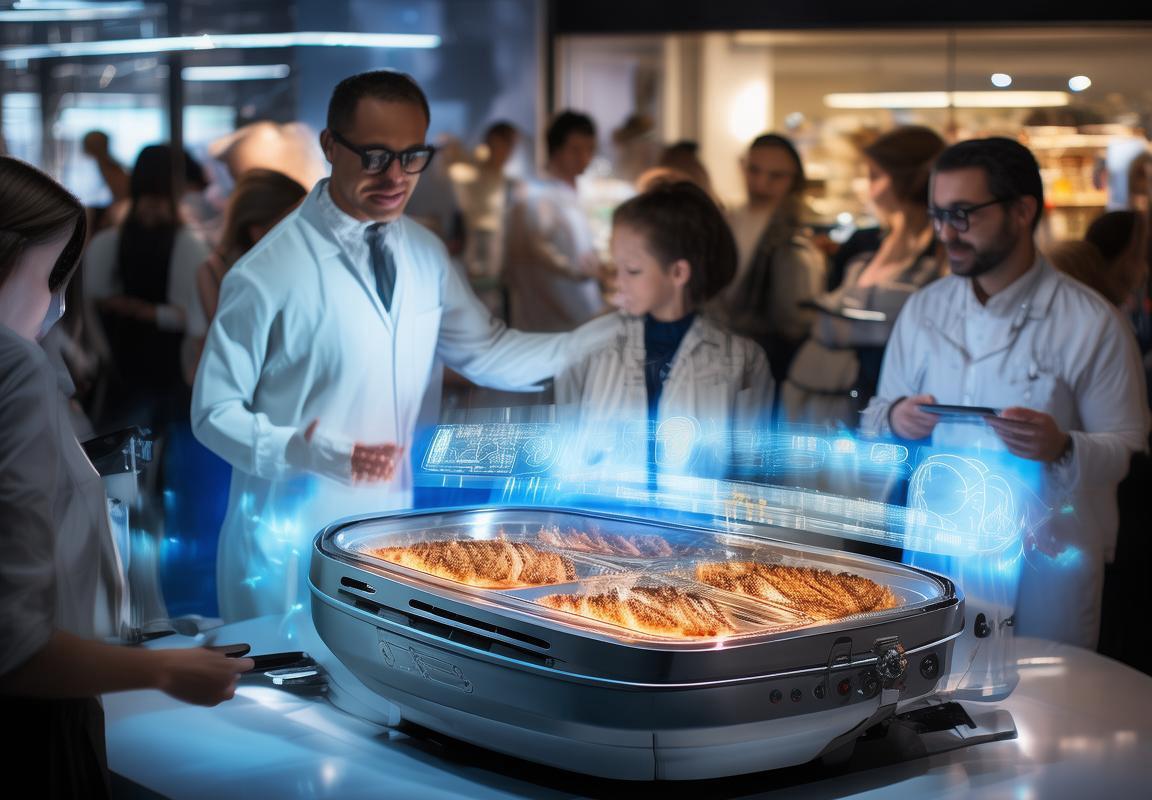
Conclusion
The contact grill market has witnessed remarkable evolution over the years, and as consumers’ preferences continue to shift, the industry faces a blend of challenges and opportunities. Producers must navigate a landscape that’s both competitive and rapidly changing. Here are some of the key challenges and opportunities they encounter:
-
Technological AdvancementsInnovations in contact grill technology are a double-edged sword. On one hand, they offer new features and functionalities that can attract consumers, such as adjustable heat settings, non-stick coatings, and advanced temperature control systems. On the other hand, they require producers to invest in research and development, which can be costly and time-consuming.
-
Market SaturationWith the growing popularity of contact grills, the market has become increasingly saturated. Producers must differentiate their products to stand out, which can be challenging given the high competition. This saturation also means that prices can be driven down, putting pressure on profit margins.
-
Environmental ConcernsAs consumers become more environmentally conscious, contact grill producers are under pressure to adopt sustainable practices. This includes using eco-friendly materials, reducing packaging waste, and ensuring that production processes are energy-efficient. Adapting to these demands can be difficult, but it also presents an opportunity to appeal to a growing segment of eco-conscious consumers.
-
Consumer Health TrendsThere’s a growing trend towards healthier eating, and contact grills offer a healthier alternative to traditional grilling methods that may involve higher smoke and oil. Producers can capitalize on this by emphasizing the health benefits of their products, such as lower fat content and reduced carcinogen formation.
-
Digital TransformationThe rise of e-commerce has transformed the way products are sold and consumed. Contact grill producers must adapt to this digital shift by optimizing their online presence, embracing social media marketing, and providing a seamless online shopping experience. This can open up new markets and customer segments but also requires a significant investment in digital infrastructure.
-
Globalization and Supply Chain ManagementThe globalization of the contact grill market means producers must manage complex supply chains that span across continents. This involves dealing with varying regulations, shipping delays, and quality control issues. While this can be challenging, it also allows producers to tap into international markets and source materials from around the world.
-
Market ExpansionThere are opportunities for contact grill producers to expand into new markets, both domestically and internationally. Emerging markets, particularly in Asia and South America, offer untapped potential for growth. Producers can capitalize on this by understanding local preferences and adapting their product offerings accordingly.
-
Collaboration and PartnershipsForming strategic partnerships with other brands, retailers, and even foodservice providers can offer new avenues for growth. For example, collaborating with gourmet food brands could lead to co-branded product lines that appeal to consumers looking for premium grilling experiences.
-
Education and BrandingAs contact grills become more common, there’s a need for producers to educate consumers about the benefits of their products. Effective branding and marketing campaigns can help establish a brand’s authority and build trust with consumers, leading to increased sales.
-
Regulatory ComplianceAdhering to regulatory standards is a challenge but also an opportunity. Producers who can demonstrate compliance with safety and environmental regulations can use this as a selling point, reassuring consumers of the quality and reliability of their products.
-
Customization and PersonalizationOffering customization options, such as interchangeable grill plates or adjustable heat settings, can cater to a wider range of consumer preferences. This personalized approach can help producers capture niche markets and differentiate their products from competitors.
-
Customer Service and ExperienceProviding exceptional customer service can be a game-changer. From pre-purchase inquiries to after-sales support, a positive customer experience can lead to repeat business and positive word-of-mouth referrals.
In conclusion, the contact grill market is fraught with challenges that require strategic planning and innovation. However, with the right approach, producers can turn these challenges into opportunities for growth and success. The key lies in staying attuned to consumer trends, embracing technological advancements, and fostering a culture of continuous improvement.